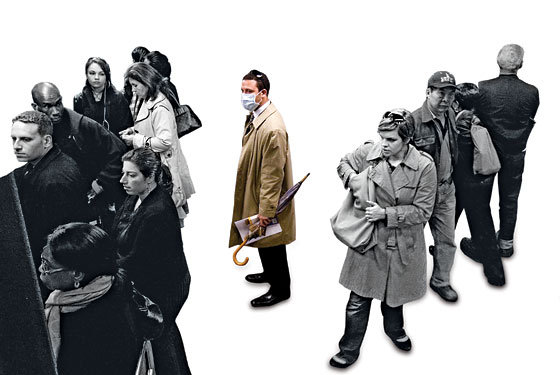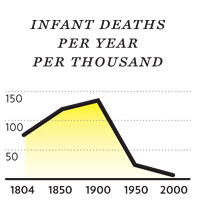
City health czar Tom Frieden, who’s leaving to run the Centers for Disease Control, expanded the idea of a “public-health emergency”—once the domain of deadly epidemics—to include societally borne ills like smoking and obesity, only to see an old-fashioned flu outbreak in his final days on the job. Tulane professor Tom Farley is his replacement. Here, a look at the city’s health-crisis history.
1790s
Yellow fever, spread by mosquitoes, kills thousands. The rich move out of the city (to where the Village is today) to avoid infection. Town elders recommend increased church attendance. Streets and homes are covered in lime dust.
1832
Tainted water spreads cholera, which claims 3,513 lives. “You could leave the house healthy,” says Columbia’s David Rosner, editor of Hives of Sickness, a city public-health history, “and by evening be lying dead in the street.” City officials urge “temperance.”

1881
Diphtheria, an airborne illness that causes mucus to develop over children’s tracheae, choking them to death, kills nearly 5,000. The city isolates patients and disinfects tenements and sweatshops but doesn’t get the disease completely under control until anti-toxins are developed (one by the city itself) a decade later.
1890s
One in four homes suffers a death from tuberculosis. Hoping to lower rates of infection in crowded conditions with better ventilation (TB is airborne), the city eventually requires that every room in a tenement has a window.
1905
Pneumonia is the leading cause of death. Officials instruct immigrant mothers how to keep a disinfected home and outfit sanitation workers in new, status-enhancing white uniforms.
1916
Transmitted largely by particles of fecal matter, polio hits New York harder than any other part of the country, killing 2,400. With many blaming “filthy” Italian immigrants, the city cancels the three-day festival of Our Lady of Mount Carmel.
1918
Twelve thousand city-dwellers die in the worldwide Spanish flu pandemic. The Health Department closes down schools and theaters and hires hundreds of visiting nurses.
1947
After twelve smallpox cases are confirmed (the disease is spread mostly through saliva), volunteers in a massive campaign vaccinate 6.3 million of the city’s 7.8 million residents in less than a month.

1981
Unusually high incidences of PCP (a life-threatening pneumonia) and Kaposi’s sarcoma (a rare skin cancer) among gay men are a harbinger of the AIDS crisis. The city refuses to close bathhouses until forced to by the state in 1985. The Health Department distributes clean needles and gives out condoms in high schools, but conservative backlash shutters both programs.
1990–1996
Drug-resistant tuberculosis spreads because of TB patients who don’t complete treatment.
2001
A Vietnamese immigrant in the Bronx dies of anthrax poisoning; it’s never been determined how she contracted it. The DOH is inundated with samples of white powder that residents suspect is anthrax.
2009
As of press time, the city has reported 227 cases of swine flu with one death. Schools close, and Frieden urges residents to wash their hands and use sanitizer. While the Department of Health is “monitoring cases closely,” says Columbia professor James Colgrove, he predicts that the swine scare will recede, allowing incoming honcho Farley to continue to focus on issues like heart disease and diabetes.